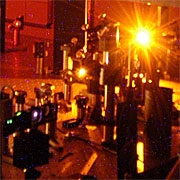Direct images, showing how the sun's energy moves inside plants, were recently obtained for the first time by researchers from Imperial College London

Direct images, showing how the sun's energy moves inside the plants, were obtained for the first time not long ago, according to a study published in early February in the scientific journal Physical Review Letters.
The images revealed the internal mechanism of the most efficient solar energy receiving process in nature - photosynthesis. Within the proteins of the photosynthesis system, the sun's energy is efficiently utilized through various cells in order to activate a chemical reaction that stores energy as food (sugars) and uses carbon dioxide for that purpose. Many scientists are very interested in harnessing this process in their search for new energy solutions to replace fossil fuels. For this, they need to understand the process of passing this energy over Burio.
Examining energy transitions is an important measurement method for understanding the detailed activity of diverse systems, from biological systems to car engines. However, in systems on a tiny scale like the cells used in photosynthesis, quantum effects come into play and make it difficult for scientists to explain how these cells are able to transfer energy with such high efficiency.
Until now, one of the most serious obstacles has been the lack of a direct method to observe some of the basic mechanisms involved in the transfer of energy between electrons and electrons.
"These new images are direct and immediate photographs of energy transferred between electrons through the protein. Surprisingly, the images also provide a revelation of the complex way in which electrons react. This provides us with the closest thing to an electron-coupling fingerprint," says Dr. Ian Mercer from the School of Physics at University College Dublin, who is the lead author of the paper describing this cutting-edge research.
The researchers examined a sample of a protein found in a bacterium called LH2, which was provided to them by the University of Glasgow. The researchers used this bacterial protein because it uses radiation in a similar way to how plant proteins do in photosynthesis. By irradiating the sample with high-powered laser pulses, the researchers were able to obtain a map of glowing points in the camera in tiny particles of the second. The position of each and every such point corresponds to a unique angle at which light is emitted from the sample, and this is directly related to the reaction of the electrons with the irradiated laser and with each other.
Alternative laser-based methods for collecting this type of information already exist, but they require that the sample be exposed to the laser radiation for a long time - a fact that leads to the decomposition of the sample. These methods also need "heavier" types of computer processing.

The researchers required a very stable and powerful laser in order for their approach to work efficiently and accurately. They found such a laser at the Rutherford Appleton Laboratory (RAL). This laser uses advanced technology developed in the physics department of Imperial College London to receive radiation with the appropriate characteristics for this experiment.
"The laser produces a wide range of colors, which allows us to map many more energy levels in the protein. The availability of this laser, which is accessible to a wide variety of scientists, opens a wide window for new and fascinating science - like the current research," explains one of the other authors of the article.
Using this laser, you can get accurate mapping with the help of a single pulse of laser radiation, that is, you can get complete information before and during the chemical reaction itself. The method can also be used for the characterization of valuable and sensitive samples because only a small amount of sample is required. Thanks to the rate of one thousand laser pulses per second, the method has a great ability to be used in fast and automatic sample characterization.
"More applications of this method are just around the corner. We hope that one day we will be able to harness to our help the amazing mechanisms we have learned from horses, whose functions have been honed over hundreds of millions of years of evolution," says the lead researcher. The researchers are now applying their approach to the fields of molecular biosciences and electronic devices.

3 תגובות
Sounds interesting, but what can be deduced from a map of bright spots? How will a few glowing dots advance the understanding of the photosynthesis process?
Confused? We too